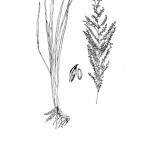Beaked Panicum , Beaked Panicgrass
Panicum anceps Michx.
Poaceae
Description
Stems grow from numerous stout, scaly rhizomes and form dense clumps. Sheaths are slightly hairy. The long leaves are hairy on the upper part near the base. The panicle is long and spreading, with slightly curved spikelets, and the inflorescence measures 6 to 16 inches or 15 to 41 cm. The second glume and lemma of the lower floret are rather widely spread at maturity, often resembling a bird beak. Flowering takes place from July to September. This very palatable grass decreases with heavy grazing. Beaked Panicum is a perennial, warm-season, native that can reach from 18 to 48 inches or 45 to 122 cm tall. Good grazing for livestock, especially horses and cattle. It provides fair grazing for wildlife, and upland birds and waterfowl will consume the seeds.Habitat
Beaked Panicum is found in the eastern half of Texas and is distributed across the eastern United States including New York, Maryland, and Florida. It grows mostly on low, moist, sandy soils in forests or in shaded, grassland pastures. Habitat types include ditches, roadsides, and riparian areas. This plant prefers shaded locations.Images
Plant Characteristics
Seed Type: Non-Encapsulated
Duration: Perennial
Stem Texture: Hairy
Growth Habit: Grasses, Sod grass
Leaf Shape
 : Simple with Pinnate or Parallel Venation
: Simple with Pinnate or Parallel Venation
Season: Warm
Distribution
 : 01 - Pineywoods, 02 - Gulf Prairies and Marshes, 03 - Post Oak Savannah, 04 - Blackland Prairies, 05 - Cross Timbers and Prairies
: 01 - Pineywoods, 02 - Gulf Prairies and Marshes, 03 - Post Oak Savannah, 04 - Blackland Prairies, 05 - Cross Timbers and Prairies
Distributions
Distribution refers to the ecological region in Texas that a plant has been found. You can also view a clickable map.
Book: Know Your Grasses (B-182)
Collection: Grasses


